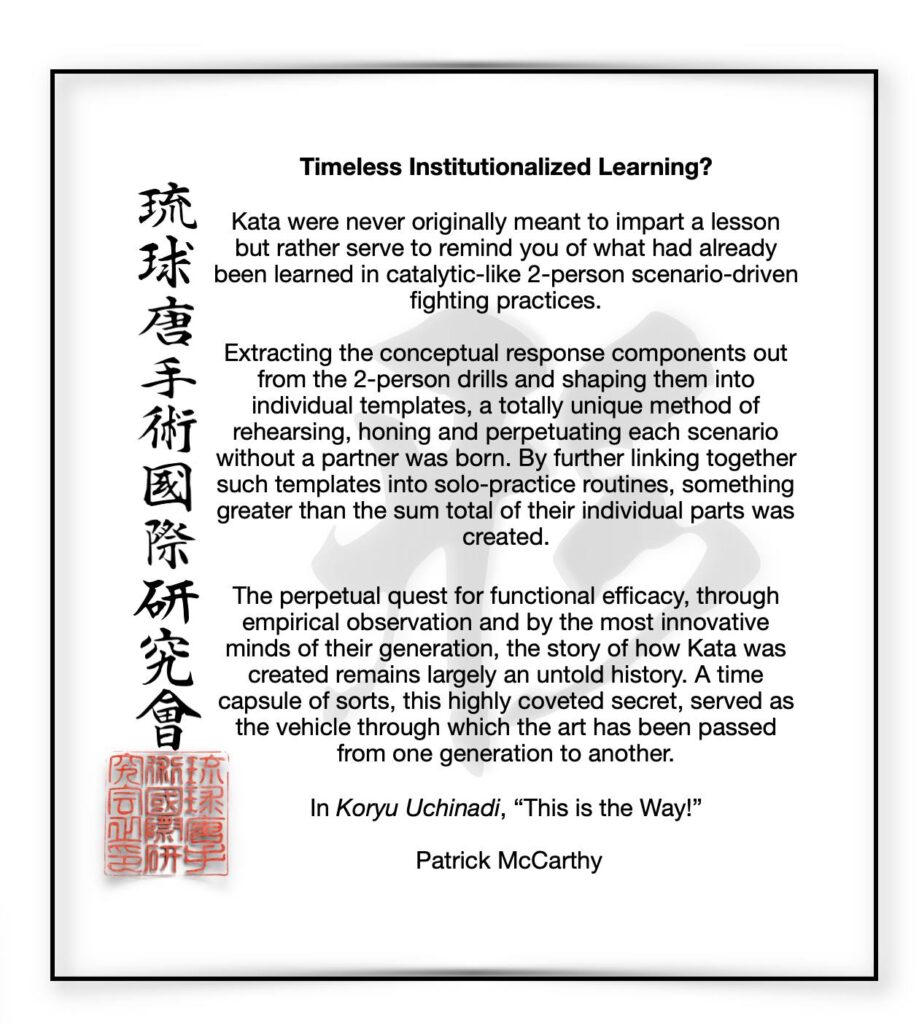
Timeless Institutionalized Learning
Kata were never originally meant to impart a lesson but rather serve to remind you of what had already been learned in catalytic-like 2-person scenario-driven fighting practices.
Extracting the conceptual response components out from the 2-person drills and shaping them into individual templates, a totally unique method of rehearsing, honing and perpetuating each scenario without a partner was born. By further linking together such templates into solo-practice routines, something greater than the sum total of their individual parts was created.
The perpetual quest for functional efficacy, through empirical observation and by the most innovative minds of their generation, the story of how Kata was created remains largely an untold history. A time capsule of sorts, this highly coveted secret, served as the vehicle through which the art has been passed from one generation to another.
In Koryu Uchinadi, “This is the Way!”
Addendum
The HAPV-Theory and corresponding 2-person application practices have long served a pathway between kata and kumite helping to empower various groups around the world find their way back out from overly ritualised and wholly dysfunctional interpretations of the original art, without needing to change styles.
Additionally, the practice of kata offers many other benefits beyond just technical skill and creative expression, such as a provocative alternative to conventional methods of physical fitness and stress management. By incorporating a variety of breathing practices, practitioners can support muscle oxygenation, improve their endurance, and regulate their heart rate, all of which can help to enhance their physical performance. Such training also promotes self-empowerment and an an inner-calm, so if/when conflict exists, it helps restore a natural balance to both personal and professional relationships.
Furthermore, the different ways in which kata can be performed – with dynamic tension, aggressive explosiveness, meditative slowness, or for aesthetic beauty – allows practitioners to adapt their practice to their specific goals and needs. Whether they are seeking to develop their strength and power, cultivate this sense of inner calm and focus, or simply showcase their physical prowess, there is a style of kata that can help them achieve their goals.
In addition, the meditative aspect of kata can be incredibly beneficial for mental and emotional health. The visualization and mental focus required to perform kata can help to quiet the mind and reduce stress and anxiety. And because kata is a holistic and non-verbal practice, it can be a particularly effective way to tap into the body-mind connection and promote a sense of unity and balance.
Overall, the practice of kata offers many benefits for both physical and mental well-being, making it a valuable component of any martial arts training regimen.
Patrick McCarthy
* PS: “A Riddle, Wrapped in a Mystery, Inside an Enigma”
I wonder what French Mathematician, Henri Poincare knew about Kata, when he wrote (in his 1905 ”Hypothesis of Mathematics”), “Science is built upon facts in the same way that a house is built with stones, but, that the mere collection of facts is no more a science than a pile of stones is a house.”
When learned indiscriminately, this profound time capsule is reduced to little more than a misunderstood cultural recreation. How many times have you learned Kata but remained completely in the dark with regards to its original defensive application? In this regard, “I liken Kata to learning a song in a foreign language; an exciting melody to the ears, but without understanding the words in which it is sung its meaning forever remains a mystery.”
1993 Seikukan AKF Lecture Brisbane, Australia
